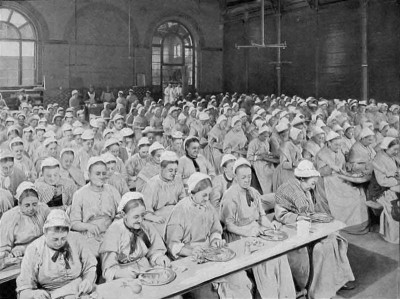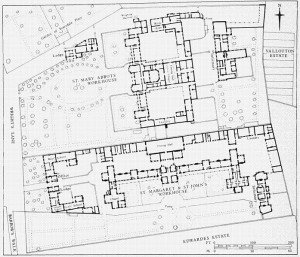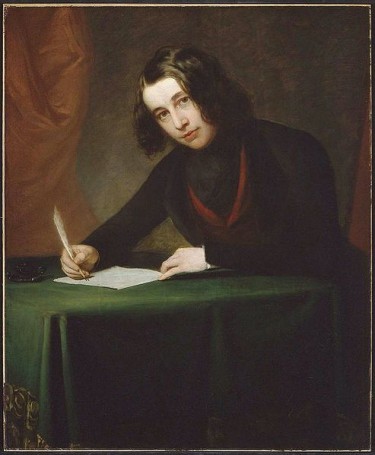A few years ago, one of my Scottish cousins decided to delve into the murky waters of family history. For a time, I received regular emails from him, dispatches containing faded photos of long-dead relatives; biographies pieced together from birth and death certificates, and short sad notes on the lives of the working poor in Edinburgh. Most of my Scottish forebearers—candlemakers, housepainters, laundresses— struggled to make ends meet in Edinburgh’s tenements. I long suspected as much. But my through my cousin’s research, I learned something unexpected and disturbing: two of my relatives died as paupers in a Victorian workhouse.
I began thinking about this again this week, for the literary world is just now beginning to celebrate the 200th anniversary of the birth of Charles Dickens, a novelist who knew all about the social injustices of Victorian England. As a boy, Dickens saw his insolvent father hauled off to debtors’ prison: Dickens was then forced to work in a blacking factory. The experience opened the young novelist’s eyes to the plight of the poor, a world that later populated his novels.
In 1850, at the height of his fame, Dickens paid a visit to a London workhouse where as many as 2000 paupers resided. In a grim piece of non-fiction writing entitled “A Walk in a Workhouse,” he later described the experience. “Groves of babies in arms; groves of mothers and other sick women in bed; groves of lunatics; jungles of men in stone-paved down-stairs day-rooms, waiting for their dinners; longer and longer groves of old people, in up-stairs Infirmary wards, wearing out life, God knows how—this was the scenery through which the walk lay, for two hours.” What struck Dickens most, however, was the sullen indifference of the inmates. Nothing seemed to matter anymore: the grinding humiliation of poverty was complete.
“Groves of babies in arms; groves of mothers and other sick women in bed; groves of lunatics; jungles of men in stone-paved down-stairs day-rooms, waiting for their dinners; longer and longer groves of old people, in up-stairs Infirmary wards, wearing out life, God knows how—this was the scenery through which the walk lay, for two hours.” What struck Dickens most, however, was the sullen indifference of the inmates. Nothing seemed to matter anymore: the grinding humiliation of poverty was complete.
So how did such human warehouses come to be? Until the Victorian era, I discovered, parish churches and towns dispensed relief to poor people in their own homes. But in 1834, British legislators passed something called The Poor Law Amendment Act, which enabled officials to force the indigent out of their cottages and into massive workhouses. There the able-bodied would work for their living and all would receive daily meals. Such a system, argued politicians, was necessary to root out idleness. Paupers living on their own simply made babies—more paupers—and lay about all day long doing nothing to help themselves. By 1839, 350 workhouses had opened their doors in Britain.
To understand how these workhouses actually functioned, I began searching for published archaeological studies of these institutions. In 2002, Gavin Lucas, an archaeologist at the University of Iceland in Reykjavik, published a paper on a workhouse he and his colleagues studied in Southhampton, England. Designed specifically as a poorhouse, the sprawling red-brick institution embodied three main principles: segregation, classification, and non-stop surveillance.
All indigent families who entered the workhouse were immediately classified and segregated by age, sex, and suitability for work. Children were separated from their parents and housed in single sex schools: husbands were taken away from their wives and shown to single sex quarters. But this was just the beginning of classification and segregation. The staff sent newly out-of-work adults to quarters by the front entrance of the workhouse; they dispatched the chronically unemployed to wards deeper inside the institution. And finally they segregated the old, the insane, the physically disabled and the diseased and contagious and placed them in wards in the dark heart of the institution. “It is almost as if the deeper you get into the building, the less your chances are of getting out alive,” Lucas wrote.
 More ominous still was the heavy level of surveillance. The staff occupied the centre of each wing, allowing them to observe everything that was going on in both the female and male wards. The poor rarely enjoyed a moment of privacy: the institution housing them acted as a panopticon, a 24-hour surveillance machine.
More ominous still was the heavy level of surveillance. The staff occupied the centre of each wing, allowing them to observe everything that was going on in both the female and male wards. The poor rarely enjoyed a moment of privacy: the institution housing them acted as a panopticon, a 24-hour surveillance machine.
Living with strangers, starving on meager rations, and subjected to constant observation, the workhouse was an institution for breaking the human spirit. Two of my ancestors, Janet Gibson and Andrew Buchanan, passed through the doors of St. Cuthbert’s Poorhouse in Edinburgh: they never returned to their families.
Upper Photo: Portrait of Charles Dickens, 1842 by Francis Alexander. Courtesy Wikimedia Commons. Middle Photo: Dinner time at St. Pancras Poorhouse, London, from The Kings Empire, 1911. Courtesy Wikimedia Commons. Bottom Photo: Plan of St. Mary Abbots Hospital, showing Kensington Workhouse, 1867. Courtesy Wikimedia Commons.

Such were the tender mercies of the dawn of industrial capitalism, which also birthed the prison industry and, in our day, the phrase “collateral damage”. The structural violence necessary to keep up the super profits of Goldman Sachs & Friends is worsening, sad to say. Contra S. Pinker.
Hi Peter: Great to hear from you. Yes, excellent point: these kind of super profits come at a terrible cost.
I guess some of my ancestors lucked out. They were in debtors’ prison in England & took the option of going to settle the frontier in Georgia. Or so I’ve been told.